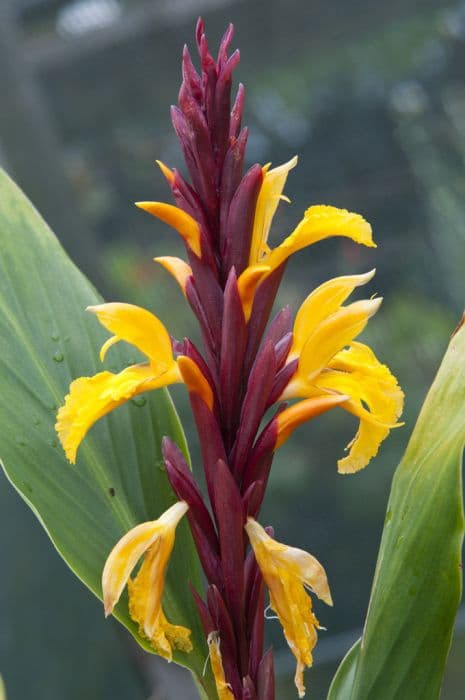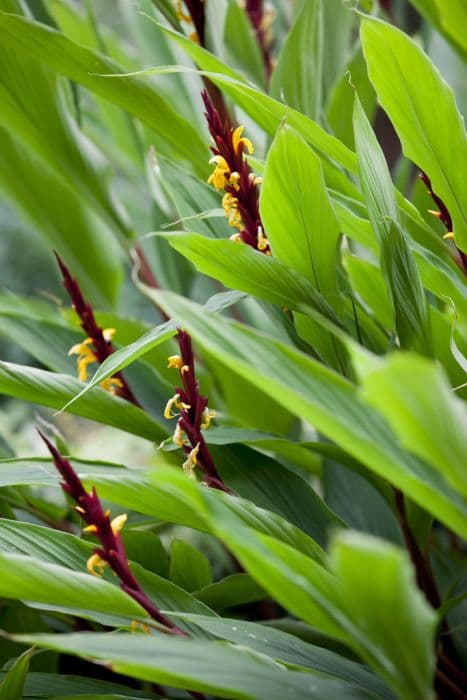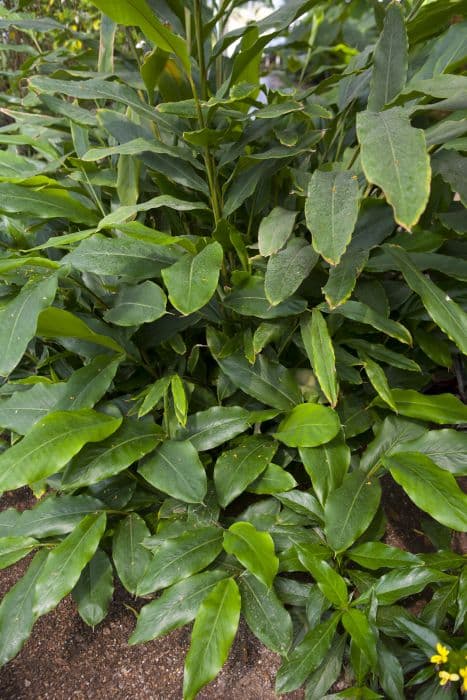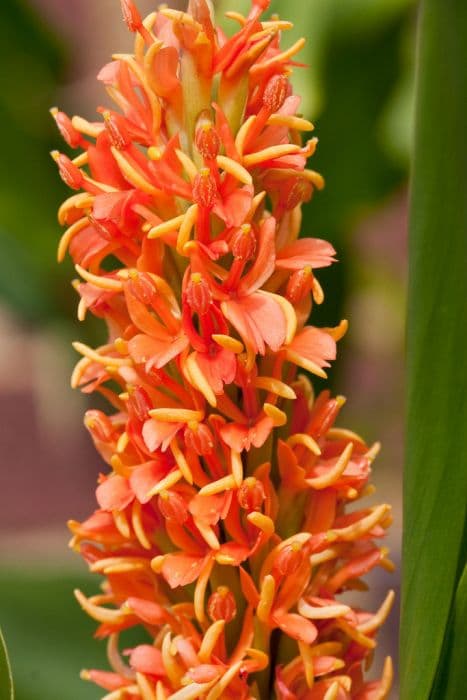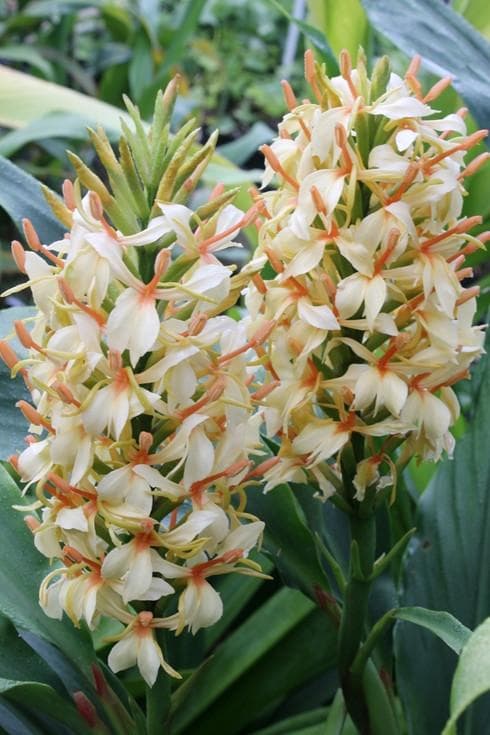Yunnan Ginger Lily Hedychium yunnanense

ABOUT
Hedychium yunnanense, commonly known as Yunnan ginger lily, is a beautiful and aromatic perennial plant known for its ornamental value. This plant produces lush green lance-shaped leaves that grow in abundance, creating a dense foliage. The leaves are typically elongated with a smooth texture and can have a somewhat glossy appearance. The most striking feature of the Yunnan ginger lily is its flowers. It blooms with clusters of delicate, fragrant flowers that are typically white or pale yellow, often with a soft orange or yellow center that adds a touch of contrast. The blooms have a characteristic funnel-like shape and are composed of several layers of petals, each layer gradually smaller than the one below it, resulting in an elegant and tiered look. These blossoms are often arranged in a dense spike-like inflorescence at the tip of the stems, standing out against the green of the leaves. The plant typically flowers in late summer to fall, depending on the climate and growing conditions. The fragrance of the flowers is sweet and inviting, contributing to its popularity in gardens and as a cut flower. The overall aesthetic of the Yunnan ginger lily is one of lushness and tropical allure, with its combination of dense greenery and striking, sweet-smelling flowers. It is often planted in groups to create a visually impressive display. However, without details of its size, the plant's presence in a garden is primarily characterized by its visual and olfactory contributions, with the impact on the landscape depending on the way it is cultivated and arranged.
About this plant
 Names
NamesFamily
Zingiberaceae
Synonyms
Yunnan Ginger Lily
Common names
Hedychium yunnanense
 Toxicity
ToxicityTo humans
The Hedychium yunnanense, commonly known as Yunnan ginger, is not widely reported to be toxic to humans. As with many plants, sensitive individuals may experience allergic reactions or skin irritation, but it is generally not considered a poisonous plant. However, caution is always recommended when dealing with plants, as some may still cause discomfort if ingested or if someone has specific sensitivities.
To pets
Yunnan ginger is not widely documented as being toxic to pets either. Nevertheless, it's important to recognize that many pets may have individual sensitivities to plants. If a pet ingests Yunnan ginger and exhibits signs of distress such as vomiting, diarrhea, or other changes in behavior, it is wise to consult a veterinarian. Generally, it's good practice to prevent pets from consuming any plants, as many can cause gastrointestinal upset or other health issues even if they aren't broadly toxic.
 Characteristics
CharacteristicsLife cycle
Perennials
Foliage type
Deciduous
Color of leaves
Green
Flower color
White
Height
4 feet (1.22 meters)
Spread
2 feet (0.61 meters)
Plant type
Herb
Hardiness zones
8
Native area
China
Benefits
 General Benefits
General Benefits- Aesthetic Value: Hedychium yunnanense, commonly known as Yunnan Ginger Lily, adds beauty to gardens with its striking flowers and lush foliage.
- Attracts Pollinators: Its fragrant blossoms attract bees, butterflies, and other beneficial pollinators, which are important for the health of the garden ecosystem.
- Cultural Significance: As with many plants, it may have cultural importance in certain regions, often used in gardens and landscaping for its unique appearance and cultural associations.
- Ease of Care: This species is often low-maintenance, making it a convenient choice for gardeners of various skill levels.
- Versatile Landscaping: Yunnan Ginger Lily can be used in a variety of garden designs and settings, such as tropical-themed landscapes or as a specimen plant.
 Medical Properties
Medical PropertiesThis plant is not used for medical purposes.
 Air-purifying Qualities
Air-purifying QualitiesThis plant is not specifically known for air purifying qualities.
 Other Uses
Other Uses- Garden Ornamentation: Due to its striking flowers and aromatic scent, Hedychium yunnanense, commonly known as Yunnan ginger lily, is often used as a focal point in tropical and subtropical gardens.
- Floral Arrangements: The vibrant blossoms of the Yunnan ginger lily can be cut and used in decorative floral arrangements to add a touch of exotic elegance to indoor settings.
- Perfumery: The fragrance of Yunnan ginger lily flowers may be extracted and used in the production of perfumes or scented oils, contributing a unique floral scent.
- Aromatherapy: The essential oils derived from Yunnan ginger lily could potentially be used in aromatherapy to create a calming and soothing atmosphere.
- Natural Dyes: Parts of the Yunnan ginger lily, such as the roots or flowers, could be used to produce natural dyes for textiles or crafts.
- Culinary Garnish: The flowers of the Yunnan ginger lily are visually appealing and could serve as an edible garnish for exotic dishes.
- Butterfly and Hummingbird Attraction: When planted in the garden, the Yunnan ginger lily can attract butterflies and hummingbirds, aiding in pollination and adding vibrancy to the garden ecosystem.
- Traditional Festivals: In some cultures, the Yunnan ginger lily may be used during festivals or ceremonies as a symbol of prosperity or for its aesthetic appeal.
- Photography Prop: The striking appearance of the Yunnan ginger lily makes it a popular subject for photographers, particularly those specializing in botanical or garden photography.
- Educational Tool: Botanical gardens and educational institutions may cultivate Yunnan ginger lily to teach students and visitors about plant biology, biodiversity, and the importance of plant conservation.
Interesting Facts
 Feng Shui
Feng ShuiThe plant Hedychium yunnanense, commonly known as the Yunnan ginger lily, is not used in Feng Shui practice.
 Zodiac Sign Compitability
Zodiac Sign CompitabilityThe Yunnan ginger lily is not used in astrology practice.
 Plant Symbolism
Plant Symbolism- Exotic Beauty: As Hedychium yunnanense, commonly known as Hardy Ginger Lily, has an attractive and unique appearance, it is often associated with exotic beauty and allure.
- Rarity: Since this plant is not as commonly found as other garden plants, it can symbolize uniqueness and rarity.
- Inviting Fragrance: The Hardy Ginger Lily is known for its pleasant scent, which can symbolize attraction and the ability to charm or welcome.
- Adaptability: Given its hardiness and ability to grow in various conditions, it can be symbolic of adaptability and resilience.
 Water
WaterThe Ginger Lily should be watered thoroughly, allowing the soil to become moist but not waterlogged. During the active growing and blooming season in spring and summer, water the plant approximately once a week with about 1 gallon of water per watering for a medium-sized plant. The frequency of watering should be reduced in the fall and winter to every two weeks or less, depending on the humidity and temperature of the environment. Ensure the plant has adequate drainage to prevent root rot. Adjust watering based on rainfall and temperature, as overly soggy soil can be detrimental to the Ginger Lily's health.
 Light
LightThe Ginger Lily thrives best in partial shade conditions, receiving bright indirect light or filtered sunlight. It should be placed in a spot where it is protected from the hot afternoon sun, which can scorch its leaves. A location that receives morning sun and afternoon shade would be ideal for the Ginger Lily to perform well.
 Temperature
TemperatureThe Ginger Lily prefers warm temperatures and grows best when the temperature is between 60 and 80 degrees Fahrenheit. It can tolerate a minimum temperature of about 50 degrees Fahrenheit, but growth will be slowed. Temperatures exceeding 80 degrees Fahrenheit may require additional shading and increased watering to keep the Ginger Lily healthy.
 Pruning
PruningPruning the Ginger Lily is done to remove spent flowers and to control the size and shape of the plant. It's best to prune after flowering to encourage new growth and more blooms in the following season. Pruning can be done once a year, or as necessary to remove any dead or damaged stems.
 Cleaning
CleaningAs needed
 Soil
SoilYunnan ginger thrives in a rich, well-draining soil mix, with a pH between 6.0 and 6.8. A mixture of loam, garden compost, and a bit of sand or perlite to increase drainage is ideal for this plant. Additionally, ensure the soil is moist but not waterlogged to prevent root rot.
 Repotting
RepottingYunnan ginger should be repotted every 2 to 3 years or when it outgrows its current container. It's best to repot in the spring, just before the growing season begins, to allow the plant to establish in its new pot.
 Humidity & Misting
Humidity & MistingYunnan ginger prefers high humidity levels, ideally between 60% and 80%. This tropical plant will thrive in an environment that mimics its natural humid habitat, though it can tolerate slightly lower humidity levels if necessary.
 Suitable locations
Suitable locationsIndoor
Place Yunnan ginger in bright, indirect light and maintain high humidity.
Outdoor
Plant Yunnan ginger in partial shade and protect from strong winds.
Hardiness zone
8-10 USDA
 Life cycle
Life cycleHedychium yunnanense, commonly known as Yunnan ginger lily, begins its life cycle as a rhizome (a horizontal underground stem) that sends out roots and shoots. Shoots emerge from the rhizome as the weather warms, developing into sturdy stems with lance-shaped leaves. The stem grows upright and, in the late summer to early fall, produces a spike of fragrant, ornamental flowers that are attractive to pollinators, such as bees and butterflies. After pollination, the flowers may develop into seed capsules that, when mature, release seeds into the environment. The plant dies back to the rhizome in winter, which then lies dormant until the next growing season. The rhizome can also give rise to new clonal plants, extending the spread of Yunnan ginger lily through vegetative propagation.
 Propogation
PropogationPropogation time
Spring to Summer
The most popular method for propagating the Hedychium yunnanense, commonly known as Yunnan ginger lily, is through division of the rhizomes. This is typically done in the spring as the growing season begins. Gardeners should carefully dig up the clump of ginger lilies and gently separate the rhizomes, ensuring that each division has at least one growth bud. The separated rhizomes should then be planted in well-draining soil at a depth of about 2 inches (5 centimeters), spaced approximately 16 to 24 inches (40 to 60 centimeters) apart to allow for ample growth. The soil should be kept moist but not waterlogged to encourage root development and new shoots to emerge. This method of propagation is straightforward and usually results in a high success rate, enabling gardeners to multiply their collection of Yunnan ginger lilies effectively.
